
A larva is a distinct juvenile form many animals undergo before metamorphosis into adults. Animals with indirect development such as insects, amphibians, or cnidarians typically have a larval phase of their life cycle.

The insect order Neuroptera, or net-winged insects, includes the lacewings, mantidflies, antlions, and their relatives. The order consists of some 6,000 species. Neuroptera can be grouped together with the Megaloptera and Raphidioptera in the unranked taxon Neuropterida including: alderflies, fishflies, dobsonflies, and snakeflies.

The caddisflies, or order Trichoptera, are a group of insects with aquatic larvae and terrestrial adults. There are approximately 14,500 described species, most of which can be divided into the suborders Integripalpia and Annulipalpia on the basis of the adult mouthparts. Integripalpian larvae construct a portable casing to protect themselves as they move around looking for food, while Annulipalpian larvae make themselves a fixed retreat in which they remain, waiting for food to come to them. The affinities of the small third suborder Spicipalpia are unclear, and molecular analysis suggests it may not be monophyletic. Also called sedge-flies or rail-flies, the adults are small moth-like insects with two pairs of hairy membranous wings. They are closely related to the Lepidoptera which have scales on their wings; the two orders together form the superorder Amphiesmenoptera.

The Tenebrionoidea are a very large and diverse superfamily of beetles. It generally corresponds to the Heteromera of earlier authors.
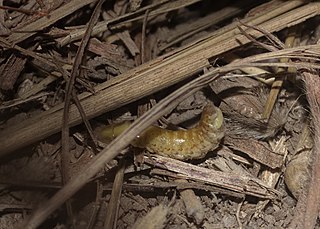
The Rhagophthalmidae are a family of beetles within the superfamily Elateroidea. Members of this beetle family have bioluminescent organs on the larvae, and sometimes adults, and are closely related to the Phengodidae, though historically they have been often treated as a subfamily of Lampyridae, or as related to that family. Some recent evidence suggested that they were the sister group to the Phengodidae, and somewhat distantly related to Lampyridae, whose sister taxon was Cantharidae, but more reliable genome-based phylogenetics placed as the sister group to the Lampyridae.
Cyclotorna is a genus of moths, the sole one of family Cyclotornidae, with five recognized species, all endemic to Australia. This family and the closely related Epipyropidae are unique among the Lepidoptera in that the larvae are ectoparasites, the hosts in this case typically being leafhoppers, sometimes scale insects. The larvae of cyclotornids, however, leave the hemipteran host and become predatory on the brood in ant nests, apparently using chemical cues to induce the ants to carry the larvae into the ant nest.
Hermann Rudolph Schaum was a professor in Berlin and an entomologist. He specialised in Coleoptera.
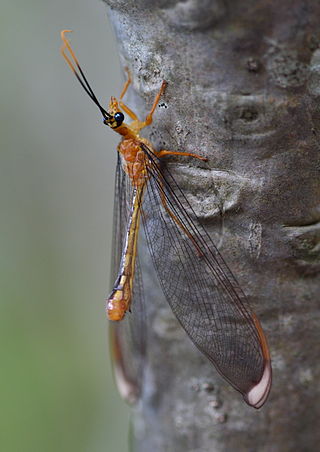
Nymphidae, sometimes called split-footed lacewings, are a family of winged insects of the order Neuroptera. There are 35 extant species native to Australia and New Guinea.

Eristalinae are one of the four subfamilies of the fly family Syrphidae, or hoverflies. A well-known species included in this subfamily is the dronefly, Eristalis tenax.
Pseudomennis is a genus of moths in the family Geometridae erected by Herbert Druce in 1885.
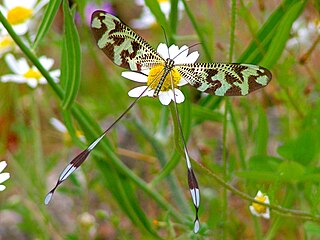
Nemoptera is a Palearctic genus of insects of the spoonwing family, Nemopteridae. All species are diurnal with an exclusively floral diet, preferring to fly in open spaces in full sunshine while visiting flowers. They can be recognized by their very long hind wing prolongations.
Harald W. Krenn is an Austrian biologist and a professor for integrative zoology at the Fakultät für Lebenswissenschaften at the University of Vienna.

Myrmeleontoidea is a neuropteran superfamily in the clade Myrmeleontiformia. Engel, Winteron, and Breitkreuz (2018) included the following families:

Myrmeleontiformia is an insect clade in the order Neuroptera, and which was historically treated as a suborder. The phylogeny of the Neuroptera has been explored using mitochondrial DNA sequences, and while issues remain for the order as a whole, such as "Hemerobiiformia" being paraphyletic, Myrmeleontiformia is generally agreed to be monophyletic, with one study giving the following cladogram:
Norapella bipennis is a moth of the family Megalopygidae. It was described by Walter Hopp in 1930.
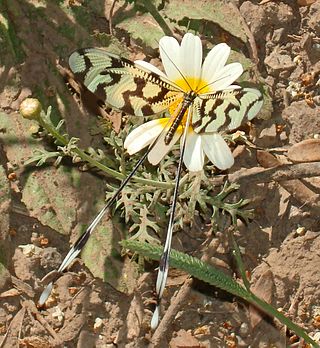
Nemoptera sinuata is a diurnal species of spoonwing lacewing or thread-winged lacewing within the spoonwing family Nemopteridae. The species is distributed throughout the Balkan peninsula, specifically found in Bulgaria, East Thrace, Greece, and North Macedonia. They inhabit forests and open grasslands, with flights near river gorges as well.
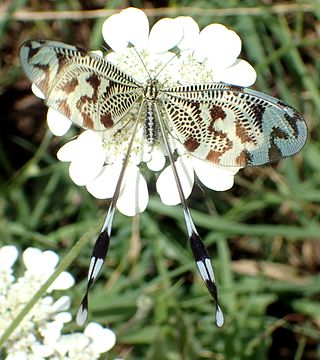
Nemoptera coa, sometimes referred to as the Grecian streamertail, is a species of lacewing within the family Nemopteridae, the spoonwing family. N. coa is native to Greece and East Thrace. There have been instances of individuals within Muğla Province within Turkey as well.

Chaemoptera is a genus in the Nemopteridae. The genus, which consists of three species, is wholly confined to Western Australia.
Chasmoptera mathewsi is an insect in the spoonwing family (Nemopteridae). found in Western Australia.
Albula nemoptera, also known as the Caribbean bonefish, threadfin bonefish, or shafted bonefish, is a species of marine fish found in the western Caribbean Sea, from Honduras west to Panama.













